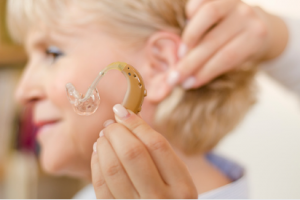Hearing aids improve the sound quality of people with hearing loss. They are classified as medical devices in most countries and are governed accordingly. Listed below are the basics of hearing aids, including the styles, batteries, and directional microphones. Before you purchase a hearing aid, be sure to read the manufacturer’s product information. You’ll be glad you did! We hope these tips have helped you choose a hearing device.
 Basic functions
Basic functions
Basic functions of hearing aids include amplifying sound and improving speech comprehension. People with hearing loss have sensorineural hearing loss, a condition that occurs when the hair cells in the inner ear are damaged. Noise, disease, and certain medicines can damage these cells. Hearing aids help restore normal hearing, which is crucial for communication. Each device is different and offers unique functions. Check out sashc.com.au/hearing-aids/ hearing aids Adelaide.
Some in-the-ear hearing aids are programmable but challenging to find because they do not allow you to change the channels. Digital hearing aids, on the other hand, have computer chips that analyze sounds in the surrounding environment. This chip can alter the sound in fascinating ways to improve speech understanding. They can also reduce background noise. First, however, you must know the difference between a T-coil and a telecoil.
Styles
There are many different styles of hearing aids available. The IIC hearing aid, for example, is one of the smallest and most discreet styles. It sits in the second bend of the ear and is nearly invisible when worn. These devices typically do not have manual controls, but they are sized to sit deeper within the ear. As a result, they are most commonly used for mild to moderate hearing loss. But they are not for everyone.
Other styles include behind-the-ear hearing aids. These devices feature a small plastic case behind the ear containing all the circuitry, and a clear tube connects the plastic case to the earmold, a custom-fit piece that delivers sound. The benefits of these devices include increased power for those with severe hearing loss. Another benefit of these devices is that they are less likely to be damaged by excess earwax. People with excessive earwax should choose behind-the-ear hearing aids. Check out sashc.com.au/hearing-aids/ hearing aids Adelaide.
Batteries
To maintain your hearing aids, you need to make sure you buy the right kind of batteries. There are many options for hearing aid batteries, and you can purchase them from a specialist. You can also purchase them online, in pharmacies, and in electronics stores. However, if you’re unsure where to buy the correct type of batteries, it is best to talk to a hearing care professional. This way, you’ll know that the batteries will be safe.
There are two main types of batteries for hearing aids. Mercury zinc batteries were the most common in the past, but more eco-friendly alternatives have been created. Zinc-air batteries work on the same principle as mercury-air batteries but have little or no mercury. These work by allowing air to enter the hearing aid and react with the zinc inside. This process creates zinc oxide, which produces energy. After inserting the battery, cover the holes with special foil to keep the air out.
Directional microphones
Research has shown that using directional microphones improves speech understanding in noisy environments. The HINT and CST tests measure SNR and per cent correct identification of sentence materials in noise. Experimental hearing aids in directional mode outperformed omnidirectional hearing aids and unaided participants. Further, they outperformed the subjects’ old hearing aid. Ultimately, directional microphones have an advantage over omnidirectional ones.
The downside of directional microphones in hearing aids is that they produce more background noise. Although the added noise is often not a problem, long-time users may prefer omnidirectional settings, which produce a higher low-frequency gain and allow greater access to environmental cues. Nevertheless, the downsides of directional microphones are outweighed by their benefits in reducing the noise generated by hearing aids.
Rechargeable hearing aids
While zinc-air batteries are popular, rechargeable batteries are the superior choice. They provide twice the power per package, do not contain heavy metals, and are more environmentally friendly. When choosing the right rechargeable option, consider the size and shape of the cell. For example, rechargeable hearing aids used size 675 cells in the past, but cosmetics dictate smaller cell sizes. Rechargeable batteries can also withstand harsher conditions than zinc-air ones, making them the ideal backup option.